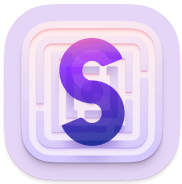Organizing your items
When using a password manager like Secrets, it's common to have a large number of items stored in it, ranging from dozens to hundreds or even thousands. To help you stay organized, Secrets provides several methods to manage and navigate your data effectively.
Using Vaults
One of the primary ways to organize your data in Secrets is by using vaults. Consider creating separate vaults for different categories, such as work and personal items. You have the flexibility to create as many vaults as you need.
Another useful vault you can create is an "Archive" vault. This vault is designed for items that you don't expect to need frequently, but you still want to keep them for potential future use. Secrets allows you to mark a vault as "disabled" to exclude it from the "All Vaults" view. This means that when searching or filtering, results from the disabled vault won't be shown. However, the disabled vault will still sync if it's an iCloud vault, and you can easily re-enable it whenever necessary.
Here's how to disable/enable a vault:
On a Mac:
- Option-click on the vault selector button next to the search field.
- Use the toggle button next to each vault to disable or enable them.
On iOS:
- Open the vault list by tapping the vault selector button next to the search field.
- Swipe left on the relevant vault to reveal a disable/enable button.
Using Tags
Tags are a convenient way to group related items together. For example, if you have a credit card, a bank account, and a login associated with the same bank, you can tag all these items with the bank's name. Similarly, you can tag logins for different family members using their names.
When searching, Secrets considers all tags associated with an item. So if you search for a tag's name, all items tagged with that name will appear in the search results.
Additionally, Secrets automatically presents a filter for each tag you create. On iOS, you can view all filters by tapping the filters button beneath the search field and swiping up. On macOS, click the ••• button beneath the search field.
To tag an item:
- Open the item and tap/click "Edit".
- Find the "Tags" section and tap/click "Show" to expand it if needed.
- Tap/click "Manage" to open the tag manager.
- If the desired tag already exists, tap/click on it to add it. Otherwise, tap/click "Add Tag" to create a new tag.
To remove a tag from an item:
- Open the item and tap/click "Edit".
- Find the "Tags" section and tap/click "Show" to expand it if needed.
- Tap/click "Manage" to open the tag manager.
- Unselect the the tag you want remove by tapping/clicking on it.
If you no longer need a specific tag, you can delete it:
On macOS:
- Click "Window" on the menubar and choose "Tags".
- Right-click on the tag you want to remove and choose "Delete".
On iOS:
- Tap the filters button beneath the search field.
- Swipe left on the tag you want to delete to reveal the delete button.
- Tap "Delete" to delete the tag.
Deleting a tag will also remove it from any items that were previously tagged with it.
Using Filters
Secrets includes several built-in filters that allow you to filter items by type, find weak passwords, or identify expired credit cards. In addition to the predefined filters, you can create custom filters1 to further refine and organize your data based on your specific criteria.
To create a filter on macOS:
- Click the ••• button beneath the search field.
- Click "New Filter".
- Provide a name for the filter and use the available options to configure it according to your requirements.
To edit or delete a filter on macOS, select the filter and then right-click on it to access the options to edit or delete it. On iOS, swipe left to delete them from the filter list.
Filters are created in the first active vault. So if you want to create it in a specific vault (like a shared vault for example) you should first select just that vault from the vault selector list.
Footnotes
-
Custom filters can currently only be created on macOS, but they will be synced to iOS and iPadOS once created. ↩
